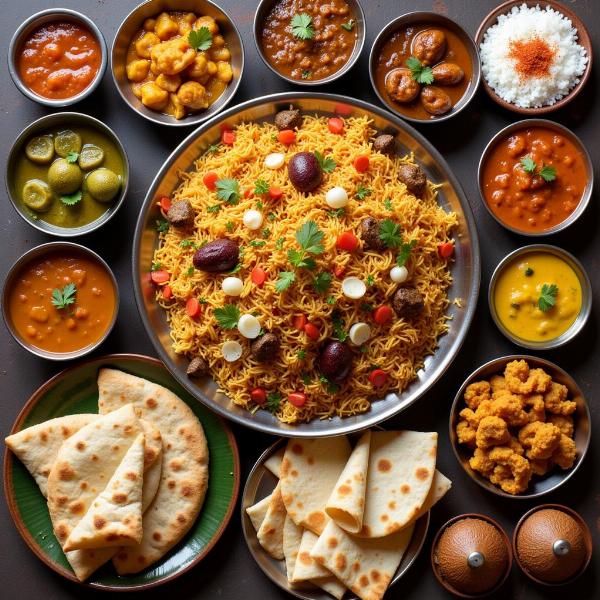Understanding the meaning of “traditional” in Hindi is key to grasping the rich cultural tapestry of India. “Traditional” often translates to “पारंपरिक” (paarmparrik) in Hindi. This word encompasses a wide range of meanings, from ancient customs and practices to inherited beliefs and artistic expressions. Knowing the nuances of this term allows you to appreciate the deep-rooted traditions that shape Indian society.
Exploring the Nuances of “Traditional” (पारंपरिक)
The word “paarmparrik” doesn’t simply refer to something old. It carries a sense of continuity, heritage, and respect for the past. It signifies practices passed down through generations, often carrying deep cultural and spiritual significance. This could be anything from religious rituals and festivals to culinary traditions and clothing styles. Think of the vibrant colors of a traditional saree or the intricate details of a rangoli design – each element tells a story of heritage and cultural identity.
Traditional Practices in Indian Society
Indian society is a melting pot of diverse traditions, varying across regions, religions, and communities. These practices are integral to daily life, shaping social interactions, family structures, and individual identities. From the elaborate ceremonies of weddings and festivals to the simple act of offering prayers at home, tradition permeates every aspect of Indian life. For example, the tradition of respecting elders is deeply ingrained in Indian culture, reflecting the importance of family and community bonds.
Traditional Arts and Crafts
India boasts a rich heritage of arts and crafts, each with its unique traditional significance. These art forms are not merely decorative; they often carry symbolic meanings and are deeply intertwined with religious beliefs and social customs. Consider the intricate carvings on temple walls or the vibrant patterns of handloom textiles – each piece represents a unique expression of traditional artistry. These crafts are often passed down through families, preserving ancient techniques and artistic styles for generations to come.
The Significance of Preserving Traditions
In a rapidly changing world, preserving traditions becomes even more crucial. These practices provide a sense of identity, belonging, and continuity, connecting us to our roots and providing a framework for understanding our place in the world. While embracing modernity is important, maintaining a balance with traditional values ensures a harmonious blend of the old and the new. As Dr. Anika Sharma, a renowned cultural anthropologist, states, “Traditions are not static; they evolve and adapt, but their core values remain, providing a sense of stability and continuity in a constantly changing world.”
Traditional Attire and its Meaning
Traditional attire in India varies widely across different regions and communities, reflecting the country’s diverse cultural landscape. From the elegant sarees of South India to the vibrant lehengas of the North, each garment tells a story of tradition, artistry, and cultural identity. Often, the colors, fabrics, and embellishments carry specific symbolic meanings, reflecting regional customs and beliefs. For example, red is often associated with marriage and fertility, while gold symbolizes prosperity and auspiciousness. Mr. Rohan Verma, a textile historian, notes that “Traditional attire is not just clothing; it is a living embodiment of cultural heritage, reflecting the history, beliefs, and artistic traditions of a community.”
 Traditional Indian Food
Traditional Indian Food
Conclusion
Understanding the meaning of “traditional” in Hindi (पारंपरिक) allows for a deeper appreciation of the rich cultural heritage of India. From ancient customs and practices to artistic expressions and traditional attire, each aspect reflects the deep-rooted values and beliefs that shape Indian society. Preserving these traditions is crucial for maintaining cultural identity and ensuring a harmonious blend of the old and the new.
FAQ
- What is the most common Hindi word for “traditional”? The most common word is “पारंपरिक” (paarmparrik).
- What are some examples of traditional Indian practices? Examples include religious festivals, marriage ceremonies, respecting elders, and various art forms.
- Why is it important to preserve traditions? Preserving traditions maintains cultural identity, provides a sense of belonging, and connects us to our roots.
- How does traditional attire reflect Indian culture? Traditional attire showcases the diversity of regional customs and beliefs through its colors, fabrics, and embellishments.
- What is the significance of “paarmparrik”? It signifies practices passed down through generations, carrying deep cultural and spiritual significance.
- How does “traditional” relate to Indian arts and crafts? Traditional arts and crafts often carry symbolic meanings and are intertwined with religious beliefs and social customs.
- How can I learn more about Indian traditions? Explore books, museums, cultural centers, and interact with local communities.
Meaning-Hindi.in is your premier destination for high-quality Hindi translation services. We specialize in various fields, including business, legal, technical, website localization, educational, and specialized translation. Our expertise in handling cultural nuances ensures accurate and culturally sensitive translations that bridge language barriers effectively. Need help with your translation projects? Contact us at [email protected] or call +91 11-4502-7584. Meaning-Hindi.in is committed to delivering exceptional translation solutions tailored to your specific needs.